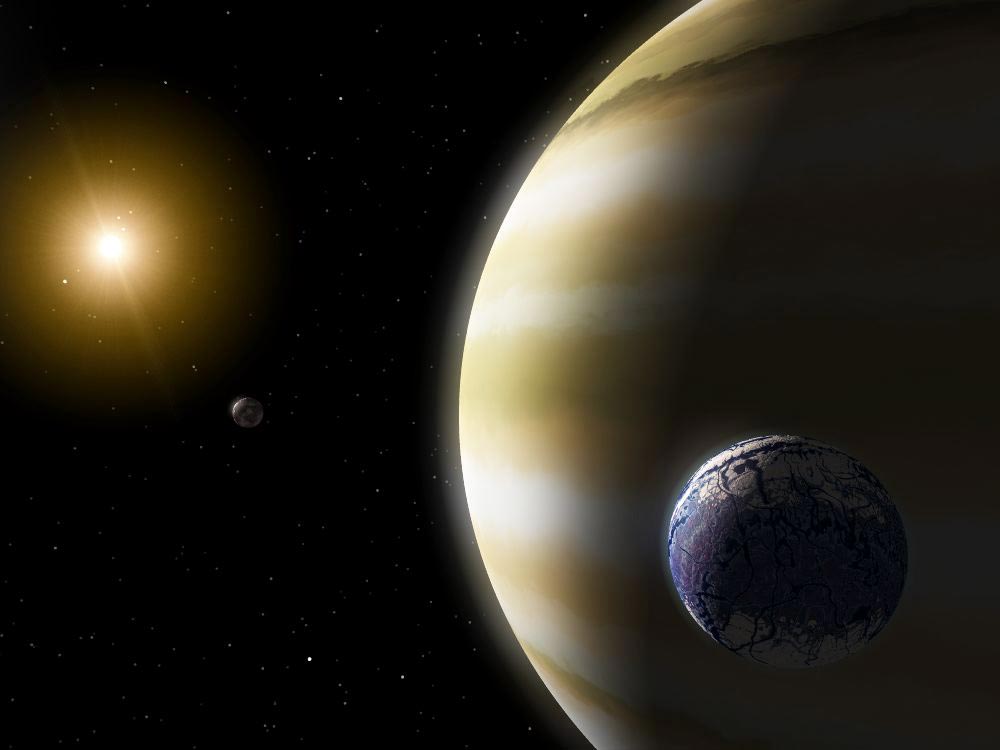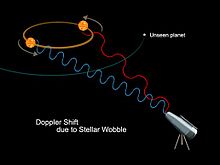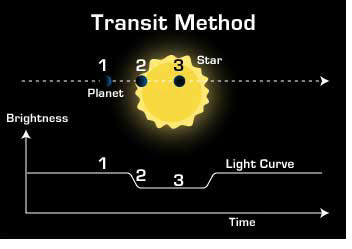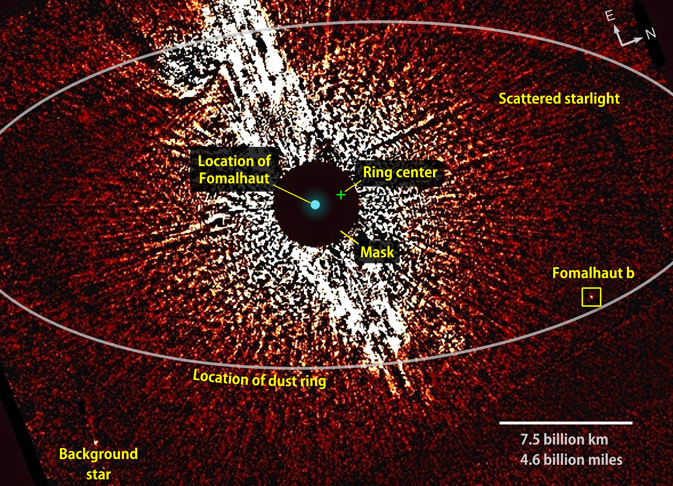The Search for Exoplanets

It seems like another day goes by and there’s another discovery of more exoplanets! On January 7, just one week into 2013, astronomers from the Kepler Mission Space Observatory announced the discovery of the latest exoplanet, the creatively named KOI-172.02. At this stage it appears that KOI-172.02 is an Earth-like planet candidate orbiting a star similar to our own sun. It almost seems like old news when scientists announce the discovery of a planet orbiting another star in our galaxy!
As at January 15, 2013 a total of 859 such planets have been identified (details can be found here). These are certainly exciting times for astronomers, but just how do astronomers search for exoplanets?
There are a number of methods used to detect exoplanets including astrometry, the transit method, radial velocity, gravitational microlensing, pulsar timing, eclipsing binaries, circumstellar disks and coronagraphy. Each method of observation has its pros and cons, is used in different circumstances, and produces different results. I will give an overview of each technique:
Astrometry is a technique that requires astronomers to precisely measure a star’s position in the sky, and then make more observations of the stars movement over time. If the star has an orbiting planet or planets, then the gravitational influence of the objects will cause the star to move in a tiny circular or elliptical orbit around the common centre of mass. Finding Earth-mass planets by astrometry requires extreme (sub-microarcsecond or 1 millionth of an arcsecond!!) precision. As the motion of the star is so small, this method has not yet been very productive in detecting exoplanets. However it’s expected that astrometric accuracy from ground-based telescopes will improve and become more useful.

One method that is very productive is the Radial Velocity method. This method requires the measurement of the velocity of a star’s centre of mass. Variations in the star’s radial velocity can be deduced from displacements in the star’s spectral lines due to the Doppler effect. If the motion of the star is towards the observer, then the received wavelengths are shorter than those emitted by the source, and longer if the motion is away from the observer. This is similar to the Doppler effect we observe in sound waves when a fire-engine passes us and the pitch of its siren changes! The Anglo-Australian Planet Search was a long-term program that searched for giant planets around more than 240 nearby solar type stars and as of 2010, discovered more than 30 exoplanets using the Doppler method. This method has been by far the most productive method of discovering exoplanets.
Another popular and effecitve method of detecting exoplanets is the Transit Method which measures the faint dip in brightness of a star when a planet transits the star (passes in front of it as observed from earth). As an exoplanet transits in front of its parent star, the observed brightness of the star drops by a very small amount. This method has emerged as one of the prevailing techniques to search for exoplanets. The amount by which the star dims depends on its size and on the size of the planet. A local example of this phenomenon was the transit of Venus across the face of the Sun in June 2004 and July 2012. The transit method is the second most productive method of detection, though confirmation from another method is usually considered necessary as dips in apparent brightness can arise from events other than a planetary transit. The Kepler Observatory uses the transit method and as of January 2013 it has discovered 2740 candidate exoplanets.

One of the more exciting, yet complex methods is Gravitational Microlensing. This method is used when the gravitational field of a star (close to us) acts like a lens and magnifies the light of a distant background star. When the alignment is exact you might think that the background star would be hidden from view, however the gravitational field of the foreground star bends the light of the background star towards us. This method has the advantage of being very sensitive to planets at large angular separations/distances from the parent stars. This makes gravitational microlensing one method well suited to finding low-mass planets. One major disadvantage is that the event can’t be repeated, as the alignment is unlikely to occur again. Also the planets tend to be very distant, so the other methods are unable to confirm the observations.
A pulsar is a fast-spinning neutron star that emits radio waves at very regular intervals as it rotates. We can use the Pulsar Timing method to discover exoplanets. Slight changes in the timing of its observed radio pulses can be used to track changes in the pulsar’s motion caused by the presence of planets. The presence of a planet orbiting a star affects the timing of the regular signals emitted by the star itself. This phenomenon can be used to detect planets around a pulsar. This method is very sensitive and is capable of detecting planets of a very small mass. In 1992, Wolszczan and Frail used this method to discover the first exoplanet around the pulsar PSR 1257+12. Unfortunately pulsars are pretty rare, so this method is not going to produce a large number of exoplanet discoveries. Also, it’s unlikely that life could survive on planets orbiting pulsars since high-energy radiation there is intense.
When a double star (binary) system is aligned such that the stars pass in front of each other in their orbit, the system is called an eclipsing binary star system. Astronomers can use the Eclipsing Binaries method to discover exoplanets. If a planet has a large orbit that carries it around both members of an eclipsing double star system, then the planet can be detected through small variations in the timing of the stars’ eclipses of each other.
Disks of dust surround many stars, and this dust can be detected because it absorbs ordinary starlight and re-emits it as infrared radiation. The Circumstellar Dust Disks method detects features in dust disks that may suggest the presence of planets. Dust is generated by collisions of small objects, including comets and/or asteroids, and radiation pressure from stars will push the dust particles out into stellar space. Therefore any detection of dust around a star indicates the possibility of recent collisions and other objects.
Lastly, a Coronagraph is an object when attached to a telescope, blocks out the direct light from a star so that nearby objects, which otherwise would be hidden in the star’s bright glare, can be observed. In the past coronagraphs have been developed to view the corona of the Sun, but new versions of similar instruments are being used to find extrasolar planets around nearby stars. Coronagraphs can be attached to either ground or space based telescopes. While stellar and solar coronagraphs are similar in concept, they are quite different in design. This is so that observations can be made of exoplanets which are much more distant than our own sun. A stellar coronagraph concept is currently being studied to fly on the Terrestrial Planet Finder mission. On ground-based telescopes, a stellar coronagraph can be combined with adaptive optics to search for planets around nearby stars.

Astronomers at the Harvard Smithsonian Centre for Astrophysics have recently estimated that as many as 17 billion earth sized planets exist in the Milky Way Galaxy alone! Yes, Billion! So I think that we’ll continue to hear about exciting new exoplanet discoveries all the way through 2013 and well beyond. By the way – if you’re really into exoplanets and consider yourself a ‘citizen scientist’ you can help discover new exoplanets! Planet Hunters is an organisation that encourages ordinary folks with no scientific training at all to help find planets from data provided by the Kepler Observatory! If you’re the first person to identify an exoplanet using their data, you’ll be included paper describing the discovery.
Harnett S (2013-01-23 00:11:43). The Search for Exoplanets. Australian Science. Retrieved: Jul 27, 2024, from http://ozscience.com/science-2/discovery-of-exoplanets-tbc/
 Follow
Follow
2 thoughts on “The Search for Exoplanets”
Comments are closed.